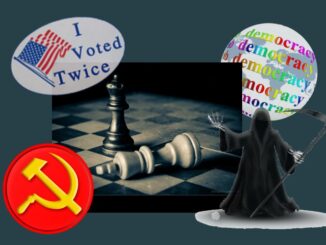
Remembering the Socialist Utopia Called Jonestown
In 1975, Rev. Jim Jones, the religious cult leader and civil rights activist, hinted at things to come.
“I love socialism, and I’m willing to die to bring it about, but if I did, I’d take a thousand with me,” he said during a sermon at his Peoples Temple church in San Francisco.
Just [three] years later, on Nov. 18, 1978, those words became reality when more than 900 people, one-third of them children, died during what would be known as the Jonestown Massacre, one of the worst mass killings in American history.
In San Francisco, Jones became a powerful figure. He curried favor with public officials and the media, donated money to numerous charitable causes and delivered votes for various politicians at election time.
Peoples Temple ran social and medical programs for the needy, including a free dining hall, drug rehabilitation and legal aid services. Jones’ message of social equality and racial justice attracted a diverse group of followers, including idealistic young people who wanted to do something meaningful with their lives.
As Jones’ congregation grew (estimates of the group’s size vary; a 1977 expose by New West magazine put the number of Peoples Temple members at 20,000), negative reports began to surface about the man referred to as “Father” by his followers.
Former members described being forced to give up their belongings, homes and even custody of their children. They told of being subjected to beatings, and said Jones staged fake “cancer healings.”
Faced with unflattering media attention and mounting investigations, the increasingly paranoid Jones, who often wore dark sunglasses and traveled with bodyguards, invited his congregation to move with him to Guyana, where he promised them they would build a socialist utopia.
In November 1978, U.S. Congressman Leo Ryan traveled to Guyana to inspect the Peoples Temple’s activities and the Jonestown compound. He was investigating rumours that some members of the cult were being held against their will and that some were being subjected to physical and psychological abuse.
After traveling to Guyana’s capital, Georgetown, on November 14, he arrived at Jonestown on November 17. The following day, when Ryan was set to return home, several Temple members who wanted to leave the compound boarded his delegation’s truck in order to accompany him back to the United States.
Other members attacked Ryan shortly before the vehicle left the compound, but he escaped unhurt, and the truck continued on with Ryan aboard.
Temple members then launched an attack at the airstrip from which Ryan and his company were to depart. Five people, including Ryan and three members of the press, were shot and killed, and 11 others were wounded.
On November 18, 1978, Peoples Temple leader Jim Jones instructed all members living in the Jonestown, Guyana compound to commit an act of “revolutionary suicide,” by drinking poisoned punch. In all, 918 people died that day, nearly a third of whom were children.
The Jonestown Massacre was the most deadly single non-natural disaster in U.S. history until September 11, 2001. The Jonestown Massacre also remains the only time in history in which a U.S. congressman (Leo Ryan) was killed in the line of duty.
To this day, when we reference any blind-faith drinking of “the Kool-Aid,” we’re talking Jonestown — even though, in some ultimate irony, the fallen faithful didn’t ingest poisoned Kool-Aid. But the barely flavored cyanide was more than enough. Jonestown is one man’s monument to charismatic madness, a road to hell unpaved with any but the vaguest of intentions, a sheep-to-slaughter moment that defies final analysis.
Sources and further reading:
https://www.history.com/news/jonestown-jim-jones-mass-murder-suicide
https://www.history.com/this-day-in-history/mass-suicide-at-jonestown
https://www.history.com/topics/crime/jonestown
https://www.britannica.com/event/Jonestown-massacre
https://www.thoughtco.com/the-jonestown-massacre-1779385
https://abcnews.go.com/US/40-years-jonestown-massacre-members-describe-jim-jones/story?id=57933856
https://jonestownmemorial.com/
https://www.biography.com/crime-figure/jim-jones
https://www.britannica.com/biography/Leo-Ryan
https://www.nydailynews.com/news/world/jonestown-massacre-takes-lives-hundreds-1978-article-1.2877618
https://www.usatoday.com/story/life/books/2017/04/10/the-road-to-jonestown-jim-jones-and-peoples-temple-jeff-guinn-book-review/100143272/
The views, opinions, or positions expressed by the authors and those providing comments are theirs alone, and do not necessarily reflect the views, opinions, positions of Redoubt News. Social Media, including Facebook, has greatly diminished distribution of our content to our readers’ newsfeeds and is instead promoting Main Stream Media sources. This is called ‘Shadow-banning’. Please take a moment and consider sharing this article with your friends and family. Thank you. Please support our coverage of your rights. Donate here: paypal.me/RedoubtNews




